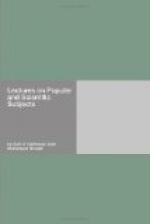What the combination of science and art has done is, however, not yet exhausted: witness the splendid specimens of artillery now produced by Sir Joseph Whitworth and Sir William Armstrong—weapons by which projectiles are thrown with an almost irresistible force. The beauty of their construction is a triumph to art, and their mathematical truth a triumph to science. One thing follows another, and no sooner have men of originality and observation perfected the means of destruction, when others press forward and furnish the means of defence. Our armour-clads, such as the “Warrior” and others which lately visited these waters, have thus been called into existence, and they are splendid specimens of what science applied to art can achieve.
The Menai Bridge is another instance of the power of man in applied science. A railway bridge is required to further communication, but Government demands that the navigation of the Strait shall not be impeded. The mind of a great man is called into action, and by applying scientific principles to engineering art, we have that wonder of the world, the great tubular bridge over the Menai Straits. This work required a mind of no ordinary nature, but such a one was found in the celebrated Robert Stephenson. I am proud to say I was privileged to have him as a friend, and I greatly lamented his death, not only as a friend, but as an irreparable loss to the world of science.
Another instance of science applied to art—and not the least important—is the adaptation of glass to form the lens which enables the flame of a lamp to be seen from a great distance. What this has done for the mariner is shown in our lighthouses, which enable him to know where he is by night as well as by day, for the lights are made to revolve, to be stationary, or to show various colours or flashes, which reveal to him their respective positions. The compass also, though ancient, is still an application of applied science, and by it the mariner is enabled to guide his ship safely over the ocean. A very beautiful instance of applied science to art is electrometallurgy, in which metals are deposited by means of the galvanic battery in any required form or shape, and this process of gilding and plating is executed with marvellous rapidity. All these various instances show what the mind of man has done, and is doing; but the applications of science to art are so endless, that even their




